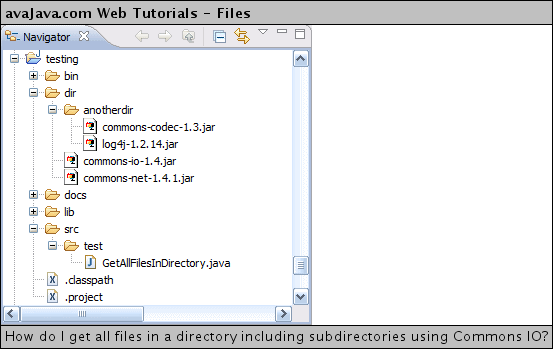

To get the files in a folder implement a FileFilter which accepts only files and pass it as a parameter to the listFiles() method.įollowing is a screen shot of the contents of the ExampleDirectory This method filters the file names passed on the passed filter. The File Filter interface is filter for the path names you can pass this as a parameter to the listFiles() method. The File Filter interface is filter for the path names you can pass this as a parameter to the listFiles () method. However, if the folder is not empty (for example contains one or more files or. The ListFiles () method returns an array holding the objects (abstract paths) of all the files (and directories) in the path represented by the current (File) object. In the above example, we have used the listFiles() method to store all files in an array.The ListFiles() method returns an array holding the objects (abstract paths) of all the files (and directories) in the path represented by the current (File) object. Removing empty directory in Java is as simple as calling lete() (standard IO) or lete() (NIO) method. Output C:\Users\Unknown\Desktop\Java Article\Language.classĬ:\Users\Unknown\Desktop\Java Article\Languages.classĬ:\Users\Unknown\Desktop\Java Article\Main.classĬ:\Users\Unknown\Desktop\Java Article\Main.javaĬ:\Users\Unknown\Desktop\Java Article\sidebar.htmlĬ:\Users\Unknown\Desktop\Java Article\Test.classĬ:\Users\Unknown\Desktop\Java Article\Time.classĬ:\Users\Unknown\Desktop\Java Article\Time.java Java 8 Read File With try-with-resources. It does not return Stream for the nested directory. I've alos added checksum and Mime-Type features so you can easily list files, check corruption, file types straight from SQL. Files.list Method Return a lazily populated Stream for the directory. Hence the first backslash is used as an escape character for the second one.Įxample 2: List files present in a Directory excluding Subdirectories import java.io.File įile folder = new File("C:\\Users\\Sudip Bhandari\\Desktop\\Java Article") i've developped a set of packages (11g), and one of them does the 'list directory contents' and provides the output in a pipelined table with all properties that are available from Java. Reading files Writing to files Traversing file.

Groovy provides easier classes to provide the following functionalities for files.
#LIST DIRECTORY CONTENTS IN JAVA HOW TO#
To understand how to display the contents of a directory in Java, follow these four steps. Groovy provides a number of helper methods when working with I/O.

Files.newDirectoryStream () List all files and sub-directories Java provides a more flexible way of traversing a directory content using Files.newDirectoryStream ().
#LIST DIRECTORY CONTENTS IN JAVA FULL#
The objects may represent files or subdirectories. To list files in a different directory, we can replace '.' with the full path of the directory we desire. This class provides the listFiles method that returns a list of File objects for a given directory. It is because the \ character is used as an escape character in Java. Displaying the contents of a directory in Java can be accomplished using the File class. The class named File of the java.io package represents a file or directory (path names) in the system.This class provides various methods to perform various operations on files/directories.

Note: We have used double-backslash while specifying the path. The list() method is used to list all the files and subdirectories present inside a directory. We have used the list() method to list all the files and subdirectories present in the specified path. Two Java examples to show you how to list files in a directory : For Java 8, Files.walk Before Java 8, create a recursive loop to list all files. In this tutorial, we will learn to list all the files and sub-directories present inside a directory.


 0 kommentar(er)
0 kommentar(er)
